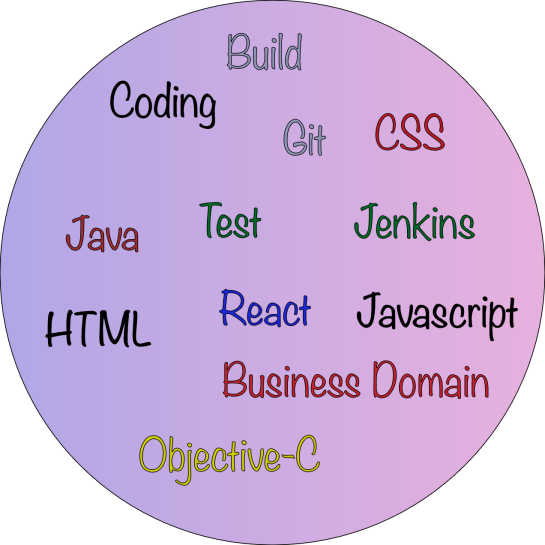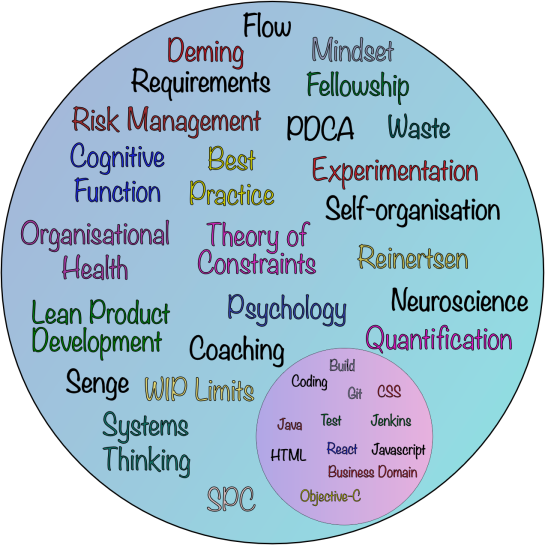Solutions Demand Problems
I’m obliged to Ben Simo (@QualityFrog) for a couple of recent tweets that prompted me to write this post:

I very much concur that solutions disconnected from problems have little value or utility. It’s probably overdue to remind myself of the business problems which spurred me to create the various solutions I regularly blog about.
FlowChain
Problem
Continually managing projects (portfolios of projects, really) is a pain in the ass and a costly overhead (it doesn’t contribute to the work getting done, it causes continual scheduling and bottlenecking issues around key specialists, detracts from autonomy and shared purpose, and – from a flow-of-value-to-the-customer perspective – chops up the flow into mini-silos (not good for smooth flow). Typically, projects also leave little or no time, or infrastructure, for continually improving the way the work works. And the project approach is a bit like a lead overcoat, constraining management’s options, and making it difficult to make nimble re-adjustments to priorities on-the-fly.
Solution (in a Nutshell)
FlowChain proposes a single organisational backlog, to order all proposed new features and products, along with all proposed improvement actions (improvement to the way the work works). Guided by policies set by e.g. management, people in the pool of development specialists coalesce – in small groups, and in chunks of time of just a few days – around each suitable highest-priority work item to see it through to “done”.
Prod•gnosis
Problem
Speed to market for new products is held back and undermined by the conventional piecemeal, cross-silo approach to new product development. With multiple hands-offs, inter-silo queues, rework loops, and resource contentions, the conventional approach creates excessive delays (cf cost of delay), drives up the cost-of-quality (due to the propensity for errors), and the need for continual management interventions (constant firefighting).
Solution (in a Nutshell)
Prod•gnosisproposes a holistic approach to New Product Development, seeing each product line or product family as an operational value stream (OVS), and the ongoing challenge as being the bringing of new operational value streams into existence. The Prod•gnosis approach stipulates an OVS-creating centre of excellence: a group of people with all the skills necessary to quickly and reliably creating new OVSs. Each new OVS, once created, is handed over to a dedicated OVS manager and team to run it under day-to-day BAU (Business as Usual).
Flow•gnosis
Problem
FlowChain was originally conceived as a solution for Analytic-minded organisations. In other words, an organisation with conventional functional silos, management, hierarchy, etc. In Synergistic-minded organisations, some adjustments can make FlowChain much more effective and better suited to that different kind of organisation.
Solution (in a Nutshell)
Flow•gnosis merges Prod•gnosis and FlowChain together, giving an organisation-wide, holistic solution which improves organisational effectiveness, reifies Continuous Improvement, speeds flowof new products into the market, provides an operational (value stream based) model for the whole business, and allows specialists from many functions to work together with a minimum of hand-offs, delays, mistakes and other wastes.
Rightshifting
Problem
Few organisations have a conscious idea of how relatively effective they are, and of the scope for them to become much more effective (and thus profitable, successful, etc.). Absent this awareness, there’s precious little incentive to lift one’s head up from the daily grind to imagine what could be.
Solution (in a Nutshell)
Rightshifting provides organisations with a context within which to consider their relative effectiveness, both with respect to other similar organisations, and more significantly, with respect to the organisation’s potential future self.
The Marshall Model
Problem
Few organisations have an explicit model for organisational effectiveness. Absence of such a model makes it difficult to have conversations around what actions the organisation needs to take to become more effective. And for change agents such as Consultants and Enterprise Coaches attempting to assist an organisation towards increased effectiveness, it can be difficult to choose the most effective kinds of interventions (these being contingent upon where the organisation is “at”, with regard to its set of collective assumptions and beliefs a.k.a. mindset).
Solution (in a Nutshell)
The Marshall Model provides an explanation of organisational effectiveness. The model provides a starting point for folks inside an organisation to begin discussing their own perspectives on what effectiveness means, what makes their own particular organisation effective, and what actions might be necessary to make the organisation more effective. Simultaneously, the Marshall Model (a.k.a. Dreyfus for Organisations) provides a framework for change agents to help select the kinds of interventions most likely to be successful.
Organisational Psychotherapy
Problem
Some organisations embrace the idea that the collective organisational mindset – what people, collectively believe about how organisations should work – is the prime determinant of organisational effectiveness, productivity, quality of life at work, profitability, and success. If so, how to “shift” the organisation’s mindset, its collective beliefs, assumptions and tropes, to a more healthy and effective place? Most organisations do not naturally have this skill set or capability. And it can take much time, and many costly missteps along the way, to acquire such a capability.
Solution (in a Nutshell)
Organisational Psychotherapy provides a means to accelerate the acquisition of the necessary skills and capabilities for an organisation to become competent in continually revising its collective set of assumptions and beliefs. Organisational Psychotherapists provide guidance and support to organisations in all stages of this journey.
Emotioneering
Problem
Research (cf Buy•ology ~ Martin Lindstrom) has shown conclusively that people buy things not on rational lines, but on emotional lines. Rationality, if it has a look-in at all, is reserved for post-hoc justification of buying decisions. However, most product development today is driven by rationality:
- What are the customers’ pain points?
- What are the user stories or customer journeys we need to address?
- What features should we provide to ameliorate those pain points and meet those user needs?
Upshot: mediocre products which fail to appeal to the buyers’ emotions, excepting by accident. And thus less customer appeal, and so lower margins, lower demand, lower market share, and slower growth.
Solution (in a Nutshell)
Emotioneering proposes replacing the conventional requirements engineering process (whether that be big-design-up-front or incremental/iterative design) – focusing as it does on product features – with an *engineering* process focusing on ensuring our products creaate the emotional responses we wish to evoke in our customers and markets (and more broadly, in all the Folks That Matter™).
The Antimatter Principle
Problem
How to create an environment where the relationships between people can thrive and flourish? An environment where engagement and morale is consistently through the roof? Where joy, passion and discretionary effort are palpable, ever-present and to-the-max?
Solution (in a Nutshell)
The Antimatter Principle proposes that putting the principle of “attending to folks’ needs” at front and centre of all of the organisation’s policies is by far the best way to create an environment where the relationships between people can thrive and flourish. Note: this includes policies governing the engineering disciplines of the organisation, i.e. attending to customers’ needs at least as much as to the needs of all the other Folks That Matter™.
– Bob






